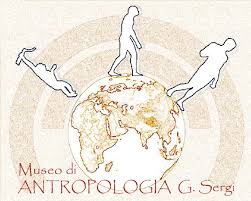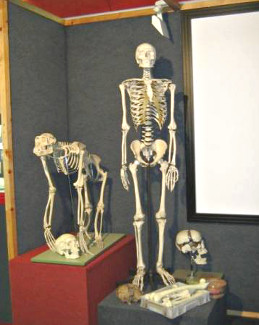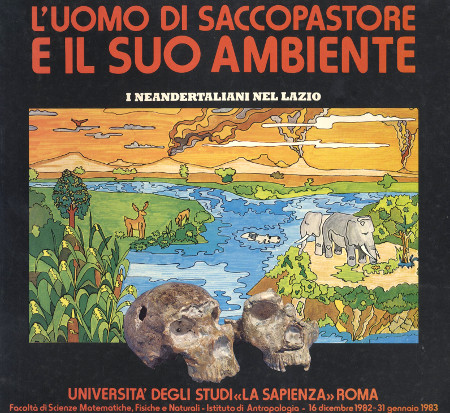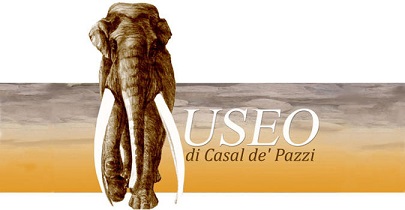

Anthropology was first taught at "La Sapienza" University of Rome in November 1884, when Giuseppe Sergi was appointed professor of this discipline. He was a philosopher, psychologist, anthropologist and teacher with multiple interests who had already taught at the University of Bologna. An initial nucleus of the museum was formed.
In 1887 the institute and museum were permanently moved to the ancient building of the Collegio Romano, a former Jesuit convent a short distance from Piazza Venezia. The entrance was a small door on the first floor which opened out onto a long corridor with furniture and shelves arranged along both walls, containing anthropological and naturalistic collections dating back to various periods and from different locations: this corridor became the "gallery" of "La Sapienza" University of Rome Museum of Anthropology. The museum was immediately considered an indispensable reference point and soon developed departments and collections, which are a valuable heritage for the study of man in his different varieties, throughout his history and evolution. Between 1929 and 1935 the museum acquired its most precious specimen: the Neanderthal craniums of Saccopastore. In 1938, under the direction of Sergio Sergi, Giuseppe’s son and one of his first students, the Institute of Anthropology and its museum were moved to the recently constructed University Campus, where they are still located today. The museum is located in large premises on the second floor of the Psychology-Anthropology building. A permanent exhibition area was also created in 1982, with the intention of spreading knowledge of Anthropology and the natural history of mankind.
![]()
Over time the Museum of Anthropology, originally oriented towards conservation activities, has undergone a profound reformation. Education has been a central point of reference both in the reorganisation of exhibition areas and the display of artefacts.
Today the Museum of Anthropology features artefacts from different stages of evolution, from Prehominids right up to Homo sapiens.
The Museum has a rich heritage, including human remains of over 6,000 individuals from all continents, from the prehistoric, protohistoric and recent ages.
Together with human skeletal remains, there are also remains of non-human primates of Cebidae, Callitricidae, Cercopithecidae, Pongidae and Panidae.
Lastly, there is a collection of anthropological instruments and plaster models as well as a valuable collection of moulds of various prehominid and hominid species, which has been remarkably enriched over the last few years.
The museum offers a variety of educational itineraries tailored on the ages of visiting students. Currently the following educational itineraries are available: for primary school children, the focus is on learning through play, specifically through the recognition of bones and their correct place in the human skeleton, the comparison between human and chimpanzees characteristics (to teach the evolution theory and the role of erect posture and successive expansion of cranial capacity and increased interactions for cultural development). The experience continues with the discovery of works by paleoanthropologists.


Thanks to the interaction between experts, teachers and school students, the focus is on curriculum subjects, drawing inspiration from the material on display; in particular, primate and human evolution itineraries are proposed. Once again, an interactive approach is used to encourage students to formulate hypotheses based on what they already know about the subject. Inaccuracies or errors are discussed with reference to previously formed ideas and knowledge acquired with extra-curricular activities.
In addition to that, upper middle school students can study the history of anthropology, as well as the evolution of scientific thought. Teacher-student interaction is used to discuss the scientific non-sense of "race", and how this deviating concept was (and unfortunately still is) used to justify genocides and conflicts.
Older middle school students, are showed the history of fossil discovery and the resulting changes in the territory. In the section dedicated to the History of Anthropology, students are particularly interested in the instruments on display which were used by Giuseppe Sergi to measure perception in his Experimental Psychology Laboratory in the late 19th century, as well as other anthropometric instruments, some of which were designed and created by Sergio Sergi himself, and even the first ever computer to be used at the university in the 60s.
Lastly, the museum constitutes a veritable lifelong learning hub also for university students.
To find out more about public opening times and contacts please go to:
http://www.musei.uniroma1.it/museodiantropologia/index.html
The Saccopastore quarry was located in the lower valley of the Aniene, the area of all the most important Palaeolithic localities in Rome, 8 km long, between Salone (at the road bridge of the Raccordo Anulare ring road) and the confluence with the Tevere river. The locations involved are known today as: Pietralata, Ponte Mammolo, Monte Sacro, Saccopastore, Sedia del Diavolo and Monte delle Gioie.

Saccopastore is the name of a meander of the river Aniene (Albula, Anio), in front of Monte Sacro, 2.5 km before its confluence with the Tevere, just north of Rome. Back in the 1930s it was still possible to distinguish three orders of terraces in which gravel (Saccopastore) and leucitic "lithoid tufa" (Sedia del Diavolo or Sediaccia) mining occurred. Over time everything has been covered by the city and nothing remains of the primitive landscape. Today, Sedia del Diavolo is Piazza Elio Callisto; the name of a short street with a few buildings bears reference to Saccopastore. Monte delle Gioie has been flattened to make room for the railway park of the Portonaccio Station. One last site in the Casal de' Pazzi area, in Ripa Mammea, to the right of the Aniene, remains for the series of Middle Pleistocene of Sedia del Diavolo.
For more information on the living conditions of Neanderthals and their ancestors, visit the Casal de' Pazzi museum.
http://www.museocasaldepazzi.it/